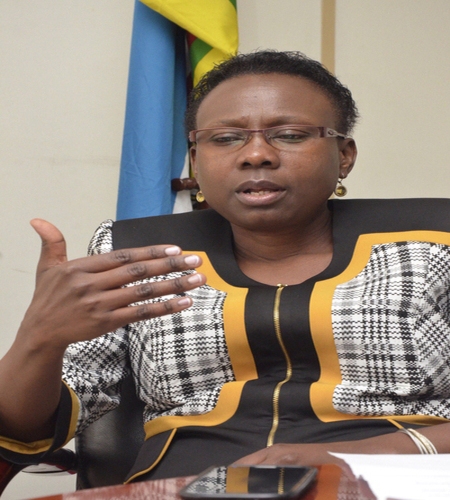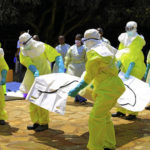The Minister of Health, Dr Jane Ruth Aceng has highly praised partnership and coordination as the key drivers for the Ebola Virus Disease (EVD) preparedness response in Uganda.
This was at the EVD accountability forum where the Ministry of Health (MoH) updated the donor community on the progress made in Ebola Preparedness in Uganda. During the forum, partners involved in the preparedness also showcased their work in the EVD preparedness response.
Dr Aceng noted that despite recording no case in the last months, “the country still maintains at a high level of preparedness because the outbreak is still ongoing in the Democratic Republic of Congo.”
“Preparedness response in Uganda remains strong due to the support of different partners under different pillars. The pillars include response coordination, surveillance,” she said
Laboratory training, case management and infection prevention and control. The other pillars include risk communication, community engagement & social mobilization, psychosocial support, vaccination and therapeutics and logistics.
She said under coordination, her ministry continues to convene regular National and district task force meetings, and cross-border meetings including two in Kasese and two others in the DRC were also held. In addition, information briefs on the EVD outbreak have been developed and given to cabinet and parliament.
Regarding Surveillance and Laboratory management, over 470 EVD samples have been tested, where an improvement in turn-around time for sample testing was registered. It is now under 24 hours.
Two mobile labs were also deployed in Kasese by the Center for Disease Control and in Kisoro with support from KfW Development Bank respectively which further reduced turnaround time to 4 hours.
The Ministry, with support from the World Health Organization (WHO) also trained 60 health workers in each of the high-risk districts in surveillance and contact tracing. At the Points of Entry (POEs), 7,900,000 million travellers have been screened at 106 POEs.
Under Case Management and Infection Prevention and Control (IPC), 60 alert cases in Kasese and 6 in Arua were recorded and managed. 361 health workers have been trained in basic case management and nutrition while 25 health workers were trained on advanced care including use of therapeutics.
With support from WHO, advanced care equipment including dialysis and blood chemistry machines have also been procured and deployed. Emergency stocking of therapeutic products has also been done with support from the United Nations Children’s Fund (UNICEF) and the World Food Program (WFP).
Concerning Water, Sanitation and Health (WASH), 1,128 handwashing facilities were provided including 572 to health facilities, 384 to schools, 44 deployed at different points of entry in 9 districts. Furthermore, WASH facilities have been improved in four health facilities and improvement is ongoing in 20 more facilities.
For Risk Communication, Social Mobilization, Community Engagement, 1,140,146 people have been reached with EVD related messaging through community engagement and interpersonal approaches with support from the Uganda Red Cross and UNICEF.
175,989 household visits have been conducted 7,390 community group meetings took place at primary schools, churches and mosques, market places, taxi, boda-boda and bus-stops as well as at funeral gatherings.
Concerning Logistics, four regional warehouses were constructed in Kabarole Kasese, Hoima and Mbarara. With support from WHO, two pickup trucks and 20 motorcycles were procured. Five ambulances also deployed Bundibugyo, Bunyangabu, Kanungu, Kasese and Ntoroko with support from WFP. The United Nations High Commissioner for Refugees (UNHCR) also provided support of three ambulances and 31 motorcycles that have been deployed in the high-risk districts.
WHO also supported MoH in the vaccination and therapeutics where 3,526 frontline and high-risk contacts were vaccinated since June 2019 bringing the total vaccinated persons 7945.
Thirty health workers and social workers have also been trained in Kasese with support from WHO to provide psychosocial support to affected patients, contacts, family and community members.
Dr Jane noted that the achievements and progress made in the preparedness response could not be achieved without the support from partners.
The WHO Representative in Uganda, Dr Yonas Tegegn Woldemariam updated the donors on the situation in the Democratic Republic of Congo (DRC). He informed them that the EVD outbreak in DRC is still ongoing with fluctuating numbers of new cases.
He further mentioned that the insecurity has played a pivotal role in hindering the management of the outbreak. “The insecurity has created a lot of difficulty for the contact tracers and follow-up teams thus losing many suspected cases in the community,” he said.
The insecurity remains an obstacle to the outbreak response in DRC as such keeping Uganda at risk.
“However, Uganda and DRC continue to work closely through information sharing to ensure that there is no imported case in Uganda,” said Dr Jane Ruth Aceng.
She also called on partners to remain committed and also create district emergency plans with annual budgets.
More recommendations from the forum include the provision of appropriate waste disposal facilities at Ebola Treatment Units, provision of Ebola kits and scanners for designated POEs, as well as creating a plan for the next six months of the preparedness response.






